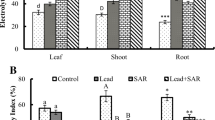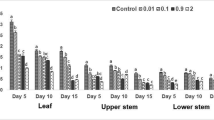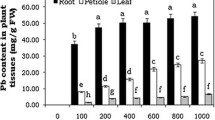Abstract
Paraquat is most extensively used methyl viologen herbicide to control weeds in the rice-Azolla ecosystem. The effects of different paraquat (PQ) dosages on growth, lipid peroxidation, and activity of antioxidant enzymes of Azolla microphylla Kaul. were investigated. The results indicated that Azolla fronds survived only at the concentrations of 2–6 μM PQ. Frond fragmentation and browning occurred after 24 h at 8 μM PQ. At 24 h, the amount of proteins decreased by 48.7 % in Azolla fronds exposed to 10 μM PQ than that in control fronds. The supplementation of 10 μM PQ increased the activities of superoxide dismutase (SOD), catalase (CAT), guaiacol peroxidase (GPX), and ascorbate peroxidase (APX) by 2,4-, 1,8-, 3,0-, and 2,2-fold, respectively, as compared with control. The content of PQ and activities of SOD, CAT, GPX, and APX were found to be positively correlated. Our study showed that PQ (2–6 μM) caused ROS overproduction in Azolla fronds, which were scavenged by induced activities of antioxidant enzymes.
Similar content being viewed by others
Abbreviations
- APX:
-
ascorbate peroxidase
- ASA:
-
ascorbate
- CAT:
-
catalase
- GPX:
-
guaiacol peroxidase
- PQ:
-
paraquat
- SOD:
-
superoxide dismutase
References
Wu, G.L., Cui, J., Tao, L., and Yang, H., Fluroxypyr Triggers Oxidative Damage by Producing Superoxide and Hydrogen Peroxide in Rice (Oryza sativa), Ecotoxicology, 2010, vol. 19, pp. 124–132.
Chagas, R.M., Silveira, J.A.G., Rafael, V., Riberio, R.V., Vitorello, V.A., and Carrer, H., Phytochemical Damage and Comparative Performance of Superoxide Dismutase and Ascorbate Peroxidase in Sugarcane Leaves Exposed to Paraquat-Induced Oxidative Stress, Pest. Biochem. Physiol., 2008, vol. 90, pp. 181–188.
Qian, H., Chen, W., Sun, L., Jin, Y., Liu, W., and Fu, Z., Inhibitory Effects of Paraquat on Photosynthesis and the Response to Oxidative Stress in Chlorella vulgaris, Ecotoxicology, 2009, vol. 18, pp. 537–543.
Peixoto, F.P., Gomes-Laranjo, J., Vicente, J.A., and Madeira, V.M.C., Comparative Effects of Herbicides Dicamba, 2,4-D and Paraquat on Non-Green Tuber Calli, J. Plant Physiol., 2008, vol. 165, pp. 1125–1133.
Singh, A.L. and Singh, P.K., Effect of Herbicide Application on Azolla Cultivation with Rice, Biofertilizers, Potentialities and Problems, Philippines: International Rice Research Institute, 1988, pp. 131–137.
Kumar, S., Habib, K., and Fatma, T., Endosulfan Induced Biochemical Changes in Nitrogen-Fixing Cyanobacteria, Sci. Total Environ., 2008, vol. 403, pp. 130–138.
Sood, A. and Ahluwalia, A.S., Cyanobacterial-Plant Symbioses with Emphasis on Azolla-Anabaena Symbiotic System, Ind. Fern J., 2009, vol. 26, pp. 166–178.
Sood, A., Prasanna, R., Prasanna, B.M., and Singh, P.K., Genetic Diversity among and within Cultured Cyanobionts of Diverse Species of Azolla, Folia Microbiol., 2008, vol. 53, pp. 35–43.
Pabby, A., Prasanna, R., and Singh, P.K., Biological Significance of Azolla and Its Utilization in Agriculture, Proc. Ind. Natl. Sci. Acad. (PINSA-B): Biol. Sci., 2004, vol. 70, pp. 301–335.
Watanabe, I. and Espinas, C.R., Potential of Nitrogen Fixing Azolla-Anabaena Complex as Biofertilizer in Paddy Soil, Philippines: International Rice Research Institute, 1976.
Calderbank, A. and Yuen, S., An Ion Exchange Method for Determining Paraquat Residues in Food Crops, Anal. Biochem., 1965, vol. 90, pp. 99–105.
Anderson, J.M. and Boardman, N.K., Studies on Greening of Dark Brown Bean Plants. VI. Developing of Photochemical Activity, Aust. J. Biol. Sci., 1964, vol. 17, pp. 93–101.
Lowry, O.H., Rosebrough, N.J., Farr, A.L., and Randall, R.J., Protein Measurement with the Folin Phenol Reagent, J. Biol. Chem., 1951, vol. 193, pp. 265–275.
Harris, N. and Dodge, A.D., The Effect of Paraquat on Flax Cotyledon Leaves: Changes in Fine Structure, Planta, 1972, vol. 104, pp. 201–209.
Velikova, V., Yordanov, I., and Edreva, A., Oxidative, Stress and Some, Antioxidant Systems in Acid Rain Treated Bean Plants, Plant Sci., 2000, vol. 151, pp. 59–66.
Giannopolitis, C.N. and Ries, S.K., Superoxide Dismutase Occurrence in Higher Plants, Plant Physiol., 1977, vol. 59, pp. 309–314.
Cakmak, I. and Marschner, H., Magnesium Deficiency and High Light Intensity Enhance Activities of Superoxide Dismutase, Ascorbate Peroxidase, and Glutathione Reductase in Bean Leaves, Plant Physiol., 1992, vol. 98, pp. 1222–1227.
Egley, G.H., Paul, R.N., Vaughn, K.C., and Duke, S.O., Role of Peroxidase in the Development of Water Impermeable Seed Coats in Sida spinosa, L., Planta, 1983, vol. 157, pp. 224–232.
Zhou, B., Guo, Z., Xing, J., and Hung, B., Nitric Oxide Is Involved in Abscisic Acid Induced Antioxidant Activities in Stylisanthes guianesis, J. Exp. Bot., 2005, vol. 56, pp. 3223–3228.
Holst, R.W., Yopp, J.H., and Kapusta, G., Effect of Several Pesticides on Growth and Nitrogen Assimilation of Azolla-Anabaena Symbiosis, Weed Sci., 1982, vol. 30, pp. 54–58.
Hassan, N.M. and Alla, M.M.N., Oxidative Stress in Herbicide-Treated Broad Bean and Maize Plants, Acta Physiol. Plant., 2005, vol. 27, pp. 429–438.
Kingston-Smith, A.F. and Foyer, C.H., Bundle Sheath Proteins Are More Sensitive to Oxidative Damage than Those of the Mesophyll in Maize Leaves Exposed to Paraquat or Low Temperatures, J. Exp. Bot., 2000, vol. 51, pp. 123–130.
Apel, K. and Hirt, H., Reactive Oxygen Species: Metabolism, Oxidative Stress, and Signal Transduction, Annu. Rev. Plant Biol., 2004, vol. 55, pp. 373–399.
Blokhina, O., Virolainen, E., and Fagerstedt, K.V., Antioxidants, Oxidative Damage, and Oxygen Deprivation Stress: A Review, Ann. Bot., 2003, vol. 91, pp. 179–194.
Lee, Y.P., Kim, S.H., Bang, J.W., Lee, H.S., Kwak, S.S., and Kwon, S.Y., Enhanced Tolerance to Oxidative Stress in Transgenic Tobacco Plants Expressing Three Antioxidant Enzymes in Chloroplasts, Plant Cell Rep., 2007, vol. 26, pp. 591–598.
Author information
Authors and Affiliations
Corresponding author
Additional information
This text was submitted by the authors in English.
Rights and permissions
About this article
Cite this article
Sood, A., Pabbi, S. & Uniyal, P.L. Effects of paraquat on lipid peroxidation and antioxidant enzymes in aquatic fern Azolla microphylla . Russ J Plant Physiol 58, 667–673 (2011). https://doi.org/10.1134/S1021443711040170
Received:
Published:
Issue Date:
DOI: https://doi.org/10.1134/S1021443711040170




